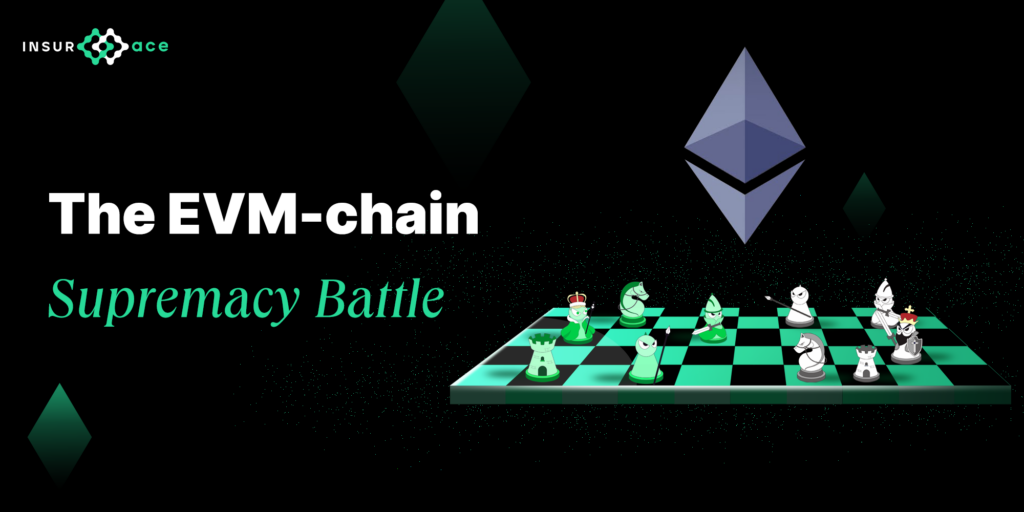When Bitcoin first hit global acclaim in the early 2010’s many blockchain enthusiasts around the world only saw Bitcoin’s distributed ledger network as a great tool for instant non-intermediated payments. Vitalik Buterin in his 2013 Ethereum Whitepaper was the first to explore the potentials for blockchain technology to serve as a secure platform for developers around the world to build applications and execute decentralized Turing-Complete smart contracts.
Today, Vitalik’s experimental proposition to deploy the Ethereum Virtual Machine – a decentralized computer system, hosted and secured by a network of independent validators around the world – has been hugely successful.
According to real-time on-chain data approximately 60% of all functioning DApps on the market are based on the Ethereum network. But when you add the number of applications built on other EVM-based networks, that figure shoots up to nearly 90%.
In this article, you will learn about the Ethereum Virtual Machine – why other platforms are copying the blueprint to develop new forked Layer 1 & Layer 2 blockchain networks — the Pros & Cons of each of them — and ultimately we will examine how the future blockchain protocols are likely to harness this unique technology to develop better secured and more efficient solutions. Let’s get into it.
Content:
- What is EVM?
- Ethereum Network – Pros & Cons
- Key Reasons for Developing Secondary EVM Chains
- Reviewing Prominent EVM Chains
- BNBhain — Pros & Cons
- Avalanche — Pros & Cons
- Polygon (MATIC) Pros & Cons
- Final Thoughts — A Multi Chain Future Beckons?
What is the Ethereum Virtual Machine (EVM)?
The Ethereum Virtual Machine as the name implies, is an open source, globally decentralized computing infrastructure that executes programs called smart contracts. It uses the blockchain to synchronize and record the system’s state changes.

DApp Statistics – Source: Stateofthedapps, June 2022.
The Ethereum Virtual Machine enables developers to build powerful decentralized applications with built-in economic functions. While providing high availability, auditability, transparency, and neutrality, it also reduces or eliminates censorship and reduces certain counterparty risks.
Ethereum Network
Ethereum is a decentralized open-source blockchain system that features its own native cryptocurrency, Ether (ETH).
The Ethereum Virtual Machine is what essentially makes Ethereum standout as the leading altcoin as it facilitates Ethereum’s unique capability to function as a launchpad for numerous other cryptocurrencies and DApps.
With the well-oiled Ethereum Virtual Machine, the native Ethereum ecosystem has achieved significant success over the years. And the numbers pretty much speak for themselves.
- 350+ million transactions executed
- 40M unique addresses
- 96% of tokens are built on Ethereum
- 2,970+ Dapps are live on Ethereum
- 52.56k Daily active users and 108.13k average daily transactions.
- Ethereum’s (ETH) MarketCap dominance hovers around ~15% of the global blockchain market value.
Key Metrics – Ethereum Network
- TVL – Total Value Locked ~ $50bn
- Transaction Fees — 0.0045 ETH ($5.19)
- Active Users — 425k
- Validator Requirement* — 32ETH
Pros
- Dynamic Smart Contract Functionality
- Fast Deployment
- Wide developer Network
- Scalability
- The Proof of Stake Merge
Key Reasons for Deploying EVM on Secondary Chains
Despite its excellent innovative features, Ethereum has come under heavy criticism more than a few times. Often leading to a number of Devs teams creating secondary forks of the EVM platform in a bid to address some of Ethereum’s inefficiencies.
Many of these secondary chains have gone on to replicate the success of Ethereum at varying levels.
- Throughput — Ethereum has perennially suffered from limited throughput leading to severe cases of network congestion over the years. At peak functionality, Ethereum has a maximum throughput of ~14 transactions per second (TPS). (Data about ethereum gas fees & congestion)
By leveraging adjusted blocktime parameters and more efficient consensus systems, secondary EVM chains are able to reach exponentially higher tps.
- Cost-Efficiency — High gas fees is a major problem that has plagued most first-generation layer-1 chains. Many new generation EVM chains are designed to lower transaction fees significantly.
This has made DApps more cost-efficient and accessible to millions of people. Secondary EVM chains have played a major role in increasing the global adoption of cryptocurrencies & decentralized applications worldwide
- ESG Concerns — Ethereum like Bitcoin and most first-gen layer-1 networks all deploy the Proof of Work consensus protocol. Governments and Environmental protectionist analysts have criticized the Proof of Stake system.
Consequently, in a bid to reduce energy demands of running DApps, developers have made efforts to deploy EVM-based smart contracts on secondary blockchain networks that utilize alternative consensus protocols such i.e. Proof of Stake.
However, it is important to note that the Ethereum main-net is on the verge of the long-awaited Eth 2.0 transition to Proof of Stake.
- Global Developer Network — Most EVM smart contracts are written in a programming language called Solidity. In the developer community, Solidity is regarded as one of the easiest languages to learn and deploy.
Several secondary EVM chains now support additional programming languages – thereby making them more developer friendly and easy to interact with by new users. A global network of developers means that new EVM chains can easily attract new projects and increase TVL within a short period.
Reviewing Prominent EVM-Based Blockchain Protocols

EVM-Based Networks: Source: DeFiLama
Today, there are dozens of Layer 1 and Layer 2 blockchain networks that have deployed the Ethereum Virtual Machine, albeit to varying degrees of success. Here’s an in depth review of some of the prominent EVM-chains.
BNB CHAIN (formerly Binance Smart Chain)
BNB Chain (formerly Binance Smart Chain) was launched in August 2020, by the centralized exchange giants. The wide network of the user on the CEX, BNB Chain has seen a meteoric adoption among users along with a dramatic surge in its project ecosystem. BNBChain is known for its low fees, and fast transaction speed. There are now well over 500 projects actively building on BSC with a TVL of ~$6 billion.
Key Metrics of BNB Chain
- TVL — ~$6bn
- Transaction Fees — ~$0.1756
- Transaction speed — 1.4 million TPS
- Active Users — 876k
- Validator Requirement — 10,000 BNB
Pros
- Low Fees
- Speed
- Accessibility
- Large Community of users provides significant reach
- Dedicated Fund for new projects
- Great customer support
Cons
- Centralized
- Steep Validator Requirement of 10,000BNB
- Relatively small number participants securing the network
- Dependence On Ethereum’s Dev Community — meaning that not much innovation is happening on BSC as projects are usually carried forward from Ethereum.
Avalanche
Launched in September, 2020 Avalanche is regarded as one of the fastest smart contracts platforms in the blockchain industry today in terms of time-to-finality. It has grown rapidly to become the third most popular EVM chain by DeFi TVL.
Optimized for speed and decentralization, Avalanche allows validators worldwide to join its network and participate in transaction nodes validation.
In terms of scalability it supports up to 4,500 transactions per second and achieves transaction finality in under 2 seconds. Any EVM smart contract enabled DApp can easily outperform its competition by deploying on Avalanche.
Key Metrics — Avalanche
- TVL — ~$3bn
- Transaction Fees — 58 nAVAX, or $0.0000064525
- Active Users — 876k
- 4,500 transactions per second
- Validator Requirement — 2,000 AVAX
Pros
- Fast transaction speeds
- Low gas fees
- Eco-friendly consensus mechanism
Cons
- High Validator Requirements
- No slashing mechanism to punish malicious activity
Polygon (MATIC)
Polygon (MATIC) is the fifth most popular EVM chain. Unlike the previous chains on this list, Polygon is a Layer 2 protocol designed to operate as a scaling solution for Ethereum. Layer 2 refers to a secondary protocol or framework that is built on top of an existing blockchain.
The main goal of these protocols is to solve the transaction throughput and scaling difficulties that are being faced by the underlying Layer 1 network.
Polygon was created specifically to help to reduce fees, increase transaction speeds, and provide developers with the throughput needed to deploy mass-market decentralized applications. With over 65,000tps, the Polygon platform now hosts to over 7,000 DApps and has a TVL of $4.9 billion
Key Metrics — Polygon (MATIC)
- TVL — ~$2bn
- Transaction Speed — 65,000tps
- Transaction Fees — Between $0.0005 to $0.2
- Active Users — ~ 500k
- Minimum Validator Requirement — 1 MATIC
Pros
- Great security
- Low fees
- Fast transactions
- Increased Scalability
Cons
- Centralization
- Risk of Obsolescence after ETH 2.0 merge
Final Thoughts — A Multi-Chain Future Beckons?
Having examined the pros and cons of these prominent EVM chains, it becomes crystal clear that, for DApps to achieve peak-efficiency, decentralization, and security, they would have to explore cross-chain solutions. The future of blockchain technology lies heavily in developing interoperable projects to drive mass-market adoption.
Multi-chain solutions, primarily Token bridges, refer to technical platforms that allow Cryptocurrencies, NFTs and DeFi protocols to be rendered, moved and managed by users across different blockchains. In our next article in this series we will provide an in depth analysis of Multi-chain Bridging solutions that exist today.


